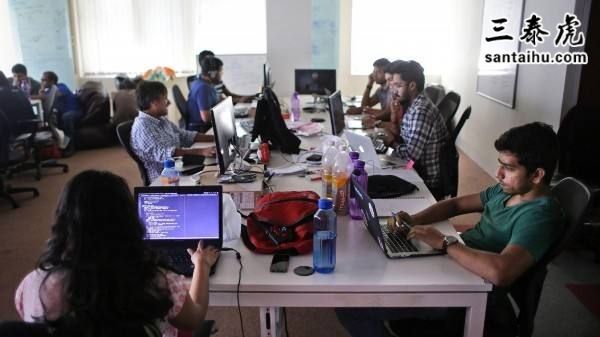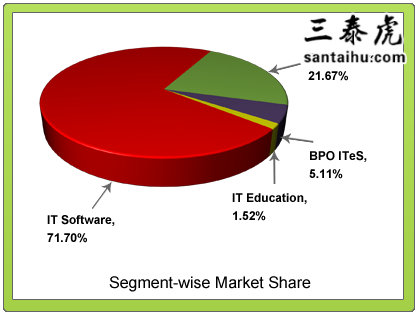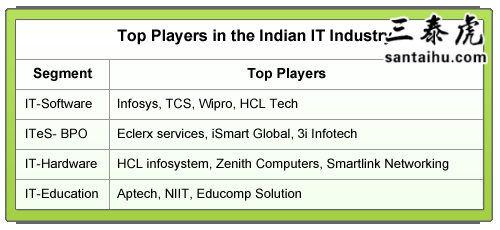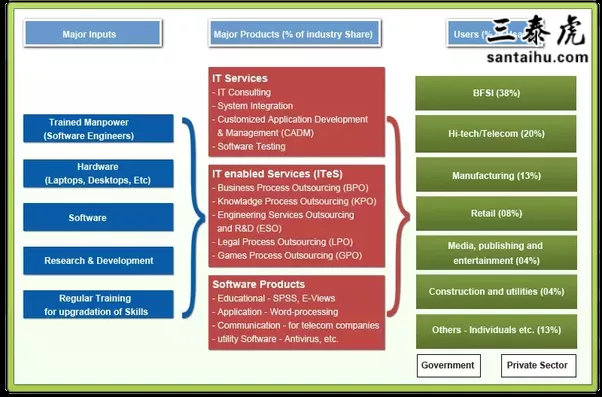美版知乎:廉价劳动力是印度IT行业成功的秘诀吗
Is "cheap labour" India's IT sector success secret“廉价的劳动力”是印度IT行业成功的秘诀吗?QUORA网站读者评论:Bala
Is "cheap labour" India's IT sector success secret
“廉价的劳动力”是印度IT行业成功的秘诀吗?
QUORA网站读者评论:
Balaji Viswanathan, Indian by Birth. Indian by Thought.
"Cheap goods" is the secret to the rise of almost every developed nation. In the 18th century, Indian weavers produced exquisite textiles with silk, cotton, wool and jute. They were stunning. But, they were also very expensive. Then the British found cheap ways to produce clothes. These were not anywhere near as good, but were good enough and were dirt cheap. These could also be run by less trained workers who were much cheaper than trained artisans.
This process, now called the "Industrial Revolution" altered world history as Britain jumped to the ranks of developed nations. At no point in time were the mechanized, mass produced clothes better than clothes produced by fine craftsmen. But, they won because they were cheap. Production of cheap textiles led to explosive side effects bringing prosperity to people.
“廉价商品”几乎是每个发达国家崛起的秘诀。在18世纪,印度的纺织工人用丝绸、棉花、羊毛和黄麻制作精美的纺织品。很美,也很贵。后来,英国人找到了廉价的制衣方法。这些衣料一点儿也不精美,但也够好了,而且非常便宜。这些工厂也可以使用不那么熟练的工人,他们比经验丰富的工匠便宜得多。
这个被称为“工业革命”的进程改变了世界历史,英国一跃成为发达国家。虽然机械化,大批量生产的衣服比不上工匠制作的精美华服。但因为他们便宜,于是他们赢了。廉价纺织品的生产带来了爆炸性的负面作用,给人们带来了繁荣。
In the 19th century, United States had its industrialization and for a long time produced "cheap" industrial goods that were considered inferior in the continental Europe. However, Americans produced a lot and those were quite cheaper compared to what an Italian craftsmen would make.
In the 20th century, Japan had its industrialization and started mass producing cheap goods. They tried to replicate every major American company with its own cheap alternative. For instance, Komatsu produced much cheaper machines for construction compared to what Caterpillar offered. The quality and support network were not there, but it was cheap.
19世纪,美国实现了工业化,并在很长一段时间内生产了被欧洲大陆认为质量低劣的“廉价”工业产品。然而,美国人生产了很多,与意大利工匠相比,美国人生产的东西要便宜得多。
20世纪,日本实现了工业化,开始大量生产廉价商品。他们试图用自己的廉价替代品来复制每一家美国大公司。例如,小松制造的建筑机械比卡特彼勒要便宜得多。虽然质量和维修网点都不能媲美,但价格便宜。
You don't become rich by selling very expensive, boutique goods. Mass production of cheap stuff has a much higher odds of making you successful. This is why Toyota is so much more valuable as a company than say Porsche or Ferrari. India's service industry is trying to follow the Toyota model - no frills, cheap, reliable output. It is quite cheap and often relies on cheap labor.
While Indian service industry initially relied a lot on cheap labor alone, it has increasingly climbed to better processes that makes the output cheaper even with rising labor costs. As long as a labour produces output much above what he earns, he is in a good shape.
靠销售昂贵的精品无法致富。便宜货的大规模生产更容易让你成功。这就是丰田作为一家公司比保时捷或法拉利更有价值的原因。印度的服务业正试图效仿丰田的模式——没有虚饰、价格低廉、产量可靠。印度服务业的价格非常便宜,经常依赖廉价劳动力。
尽管印度服务业最初很大程度上仅依赖廉价劳动力,但它的流程已逐渐得到提升,即使劳动力成本不断上升,也能降低产出成本。只要一个劳动者创造的产值远远高于他的收入,就没问题。
Dillon Borges, lived in India (2016-2017)
Very much so. Why do you think so many young Indian engineers and scientists and so on hastily leave the country. Labour is cheap, and in India the smarter you are the less you are paid.
There is a massive over supply of these college graduates such that they either work as overqualified labourers or work as underpaid ones. Given the status of engineer, doctor or laywwr in India most go for underpaid.
Why go far, look at this prestigious Mars mission. It costed less than 45 million USD. Meanwhile, India signed a contract with France to buy Rafale fighter aircraft at I believe 150 million USD PER PIECE. Think about that for a moment. 150 million per plane, that sounds normal for a high tech, 4.5 generation multirole combat aircraft... that is mass produced.
说的很对。不然你以为,为什么那么多年轻的印度工程师和科学家着急火燎地离开这个国家?劳动力很廉价,在印度,你越聪明,得到的报酬就越少。
大学毕业生的供应严重过剩,他们要么成为大材小用的劳工,要么成为报酬过低的劳工。在印度,就算是工程师、医生或律师,大多数工资都偏低。
为什么要走这么远,看看著名的火星登陆计划。花费不到4500万美元。与此同时,印度与法国签署了购买阵风战斗机的合同,每架价值1.5亿美元。好好想一下。一架飞机1.5亿美元,对于一架4.5代多用途高科技战斗机来说,这听起来很正常……这是大批量生产的。
45 million for a probe that goes to Mars, not per unit, but including development costs, a one off product, each component painstakingly crafted to perfection. To Mars. How is it possible. The salary of the team alone should have been twice that much.
So while the Dassault Rafale crew in France drives from work in their Mercedes AMG or Maserati to their big suburban house, the seriously underpaid ISRO researcher takes the bus to their small city apartment.
Is it fair? You decide.
一架飞往火星的探测器花费4500万美元,包含了研发成本,只有一架成品,每一个组件都经过精心制作,力求完美。能到火星上去。这怎么可能呢?单是研究团队的工资就应该是这个数字的两倍。
因此,当法国的达索阵风机组成员开着梅赛德斯或玛莎拉蒂从办公室回到他们位于郊区的大房子时,薪酬严重过低的ISRO研究人员却只能乘公共汽车前往他们的城市小公寓。
公平吗?你说呢?
Naveen Rauthan, Engineer
1.IT- Software – These companies help in developing and implementation of different software for their clients worldwide. These software could be for documentation, security services, banking softwares etc.
- ITeS Business process outsourcing (BPO) – Major Corporations across the world outsource their back-office operations to some companies. E.g. Employee payroll for a US company’s global workforce is maintained by an Indian BPO. Slowly the definition is expanding to Human resources, accounting, logistics, legal processes etc.
- IT- Hardware and peripherals - The stuff you can actually see and touch, and would likely break if you threw it out a fifth-story window, is hardware. This would include laptops, desktops, Storage devices, Networking devices, LCD, printers etc.
1. IT-软件-这些公司帮助他们的全球客户开发和实施不同的软件。这些软件可以用于文档处理、安全服务、银行软件等。
2.服务业务外包 -世界各地的大公司将他们的后台业务外包给一些公司。美国公司全球员工的工资由某家印度业务流程外包公司负责。慢慢地,这种外包扩展到了人力资源、会计、物流、法律程序等领域。
3.IT-硬件和周边设备—你可以看得到、摸得到,被你从五十层楼的窗户扔出去的话可能会砸坏,这就是硬件。这包括笔记本电脑、台式机、存储设备、网络设备、液晶显示器、打印机等。
- IT- Education This segment provides training for employment in the other segments. This would include companies providing various certification courses, like Java, Oracle etc. These companies also provide training for employees in corporate sector. Recently, some companies have also expanded this service to cater to schools and colleges.
This sector has made significant contributions to India’s economic growth in terms of GDP increase, foreign exchange earnings as well as employment generation. Its contribution to GDP has increased tenfold in last decade, from 0.6% to 6% till 2009-10. The sector has helped India transform from a rural and agriculture-based economy to a knowledge-based economy. Besides this, the lives of people have been positively influenced by direct or indirect contribution of IT sector to various parameters such as employment, standard of living, per-capita income etc.
4.IT-信息技术教育。为其他行业的就业提供培训。包括提供各种认证课程的公司,如Java、Oracle等。这些公司还为企业部门的员工提供培训。最近,一些公司也扩大了这项服务以迎合中小学和大学。
在GDP增长、外汇收入和就业方面,该行业为印度经济增长做出了重要贡献。它对GDP的贡献在过去十年中增长了十倍,从0.6%增长到2009- 2010年的6%。该行业帮助印度从一个以农村和农业为基础的经济向着知识经济转型。除此之外,IT部门对就业、生活水平、人均收入等各项指标的直接或间接贡献也对人们的生活产生了积极的影响。
In India, the IT Software segment has seen significant growth and has put India on the global map. It contributes for almost 75% of the total revenues of the IT sector. Though Hardware enjoys second place in terms of market share in India, it is quite low as compared to global benchmark. The BPO segment has grown well and is expected to make a footprint in the IT Sector.
Functioning of Software segment is explained pictorially in the figure below:
在印度,IT软件行业取得了显著的增长,使印度跻身全球版图。它几乎占It部门总收入的75%。尽管硬件在印度的市场份额位居第二,但与全球基准相比还是相当低的。业务外包行业的增长良好,将在IT部门留下印迹。
软件行业的运作如下图所示:
The software sector is service-oriented and thus the products offered are tailored to the requirement of its client. Hence, major input costs are those of human resources (forming almost 40% of the total costs) and research and development. Companies understand the requirements of clients and the product is developed accordingly.
In the last ten years the IT sector in India has grown at an average annual rate of 28%. India has emerged as the preferred destination for IT services owing to the cost advantage and talent pool.
India accounts for almost 51% of the global sourcing market. Exports contribute around 75% of the total revenue of the IT sector in India. However due to increased export-orientation and lesser domestic consumption the sector suffered major hit in the recession that shook the globe in 2008-09. In the year 2010, different economies began seeing recovery, but at varying pace. Indian companies have subsequently begun tapping other geographical markets and domestic consumption has also relatively increased.
软件行业是以服务为导向的,提供的服务要根据客户的需求来定制。因此,主要的投入成本是人力资源成本(约占总成本的40%)和研发成本。公司了解客户的需求,开发相应的产品。
在过去的十年里,印度的IT部门以年均28%的速度增长。由于成本优势和人才储备,印度已成为IT服务的首选目的地。
印度占全球信息市场的近51%。出口占印度IT行业总收入的75%左右。然而,由于出口导向增强和国内消费减少,该行业在2008-2009年波及全球的经济衰退中遭受重创。2010年,各个经济体开始复苏,但速度不同。印度企业随后开始进军其它市场,国内消费也相对增加。
Ashutosh Mehndiratta, Curious Indian
Yes, Labor Arbitrage is a big factor in growth of India's IT sector into a $100 billion business with over 3 million IT workers.
However, if "cheap labour" was the only secret to success in IT, we would have seen following -
- Mexico, which is right next to US in the same time zones, would have jumped and grabbed the $100 billion business rather than having its citizens cross the US border illegally and take up lower end jobs.
- China has millions of cheap laborers who slog in factories in inhuman conditions. Yet it's not hub of IT offshoring.
- Same for Indonesia, Vietnam, Cambodia, Thailand, Nigeria, Brazil that have large populations and millions of cheap laborers.
是的,劳动力套利是印度IT行业成长为拥有300多万IT员工、价值1,000亿美元的行业的一个重要因素。
然而,如果“廉价劳动力”是IT业成功的唯一秘诀,我们可能会看到以下情况
—墨西哥,就在美国旁边,处于同一个时区,可以争取抓住这1000亿美元的商业机会,而不是让其公民非法越过美国边境从事低端工作。
—中国有数百万廉价劳动力,他们在非人的条件下在工厂里辛勤劳作。但中国并不是IT外包的中心。
—印度尼西亚、越南、柬埔寨、泰国、尼日利亚、巴西也是如此,这些国家人口众多,劳动力廉价。
So why is India winning at this game?
English language - US and UK are largest markets for IT offshoring and India has the largest pool of English speakers.
Engineering talent - I agree, the quality of today's private Engineering colleges in India and their graduates is questionable. But if you look at the first phase of outsourcing in late 90s, it was full of talented, qualified engineers who shook the US IT market by delivering better outcomes at a fraction of prevailing costs.
那么为什么印度会在这场比赛中获胜呢?
英语——美国和英国是IT外包的最大市场,而印度拥有最大的英语用户群。
工程师人才——我同意,印度现在的私立工程学院及毕业生的质量是有问题的。但如果你看看上世纪90年代末第一波外包潮,就会发现当时有很多才华横溢、有资质的工程师,他们以比当时成本更低的价格更好地完成了工作,震撼了美国IT市场。
IT Visionaries of India - It was visionaries like Narendra Patni who graduated from IIT and later MIT who envisioned an offshore model. Infosys founders were initially employees of Patni Systems. Another MIT grad - F. C. Kohli who laid foundations of Tata Consultancy Services was the grand visionary of India's IT industry. Another name that comes to mind is Dewang Mehta (1991-2001) - the young man behind NASSCOM. Note that other populous countries did not have such visionaries. Comparatively, it's the same story in developed countries. Not every technology worker in US is super smart...millions of Americans reap benefits of foundations laid by American Visionaries like Bill Gates, Steve Jobs, Larry Ellison, Mr. Hewlett, Mr. Packard, and so on.
印度IT的远见者——像纳伦德拉•帕特尼这样有远见的人,他毕业于印度理工学院,后来又毕业于麻省理工学院,他设想了一个离岸模型。Infosys的创始人曾是Patni Systems的雇员。另一位麻省理工学院毕业生、塔塔咨询服务公司创始人柯利是印度IT行业的伟大梦想家。我还想到另一个名字德旺梅塔(1991-2001)——NASSCOM背后的年轻人。请注意,其他人口大国没有这样的远见卓识。相比之下,发达国家的情况是一样的。并非美国的每一位科技工作者都超级聪明……数百万美国人从比尔·盖茨、史蒂夫·乔布斯、拉里·埃里森、休利特、帕卡德等美国空家建立的基金会中获益。
First mover advantage - When the first few batches of IT workers set up a solid foundation in late 90s, India earned a formidable spot in the world. Not just technical skills, there were thousands who had solid understanding of domains like Telecom, Banking, Insurance, etc. When a Western client wanted to outsource work that was worth few thousand employees, only Indian companies could stand large teams who could transition that work and have the Process Maturity to take it on without introducing risk in client's routine business.
Future of India's IT industry - While it has been a good run for last 15+ years, things may not continue in a straight line. New technologies like Cloud, Virtualization, Automation are making IT systems less dependent on armies of people. Future winner's will have to build their strategy accordingly. New set of visionaries will appear. They will not appear randomly out of Timbuktu. They will appear out of regions that have healthy ecosystems of technology as well as hunger to win - US-(Silicon Valley, East Coast, North Carolina Research Triangle, Seattle), Israel, India - (Bangalore, Pune , Chennai, Gurgaon), Europe - Sweden, Finland, Germany, China, Taiwan, Singapore.
先发优势——当第一批IT工作者在90年代末打下坚实的基础时,印度在世界上赢得了令人敬畏的地位。印度有数千名不仅有技术,还非常了解电信,银行,保险等行业的人才。当西方客户想把几千名员工的工作外包出去时,只有印度公司拥有大型团队,能接手工作,不会给客户的日常业务带来风险。
印度IT行业的未来——尽管IT行业在过去15年多的时间里一直运行良好,但未来可能不会一马平川。云计算、虚拟化和自动化等新技术使IT系统对员工规模的依赖逐渐降低。未来的赢家将不得不制定相应的战略。新的梦想家将会出现。他们将出现在拥有健康技术生态系统和渴望成功的地区——美国(硅谷、东海岸、北卡罗来纳州三角研究中心、西雅图)、以色列、印度(班加罗尔、浦那、金奈、古尔冈)、欧洲——瑞典、芬兰、德国、中国、中国台湾、新加坡。
Eshwar
Cheap is a relative term. India’s engineers & other graduates that have entered the IT industry include some of best talent that has entered workforce. While their salaries may be ‘cheaper’ in dollar terms, they represent some of the best that India has to offer to the world. So, it is a win-win for both India and the international clients looking for IT services.
However, this cost arbitrage is beginning to erode as salaries rise in IT sector in India, and technology-landscape changes dramatically. The next wave of Indian resurgence in IT will have to come from thought leadership and innovations in product and technology development. ‘Cheaper labour’ can no longer be its USP
廉价是一个相对的说法。进入IT行业的印度工程师和其他毕业生中,有一些已经进入职场的最优秀的人才。虽然按美元计算,他们的工资可能“更便宜”,但他们代表着印度向世界提供的一些最高水平的服务。因此,这对印度和寻求IT服务的国际客户来说是双赢的结果。
然而,随着印度IT行业薪资的上涨和技术领域的巨变,这种成本套利正开始减弱。印度IT业的下一波复苏将必须来自思想领袖和产品及技术开发方面的创新。“廉价劳动力”将不再是其卖点。
Shad Raza, An Enthusiast Strategist & Tech loving guy
Absolutely not!
In today's global market no one is giving contract just for cheap labour. Price is one of the factors but not the only one. In IT sector Indians have invested not only creating just Eco system of learning where students can learn through robust processes in universities but schools are paying attention since many years. Innovating & contributing to IT sectors through these years are also one of the reason. By these continuous efforts they have created their credibility in the world market through which these peer nations are recognizing them. So are getting success purely based on merit.
绝对不是!
在当今的全球市场上,没有人会仅仅因为廉价劳动力而签订合同。价格是一个因素,但不是唯一因素。在IT行业,印度人不仅投资创建了生态学习系统,让学生可以在大学里通过健全的流程来学习,多年来学校也一直在关注这一问题。这些年来的创新和对IT行业的贡献也是原因之一。通过这些不断的努力,它们在国际市场上建立了信誉。因此,印度获得成功纯粹是基于这些优点。
Anonymous
The Indian software industry, in most cases, appears
to be like McMcDonald's. The food(software) is cheap, and just good enough to get the job done. No innovation, and the quality is just good enough- the bare minimum to make the cut. The people working here are paid peanuts.
A job at McDonald's does not really command much respect, unless you're in mid-senior management. The same is the case with our software industries. Both command low pay, low status, and are very commonplace
在大多数情况下,印度的软件行业就像麦当劳一样。食物(软件)很便宜,也刚好足够完成这项工作。没有创新,服务质量正好满足要求—这是成功的最低要求。员工的工资很微薄。
麦当劳的工作并不能真正赢得很多尊重,除非你是中层管理人员。我们的软件行业也是如此。两者都是低工资、低地位,非常平庸。
Sunil Prabhakaran, Built IT solutions for Enterprises
Balaji has already given a comprehensive answer.
Adding one more dimension to it with a completely unrelated experience i had in 2014.
It was during an Indian Premier League Cricket game at Chinnaswamy stadium in Bangalore. One such machine used in day-night cricket encounters in the sub-continent is a super sopper to absorb all the dew off the grass so that the batting side don’t have an advantage. Now two such huge machines were at works to dry the ground. Midway into operation one of them broke down in the middle of the ground. Nothing made the machine move and the operator had to call in a mechanic. The umpires were keen to get the game started but the machine didn't budge despite mechanic's efforts. Finally the entire stadium staff were called in and the machine was lifted off the ground.
Balaji已经给出了一个很全面的答案。
2014年,我有过一次完全不相干的经历,可以补充一下。
那是在班加罗尔Chinnaswamy体育场举办的印度板球超级联赛期间的事。在印度次大陆,板球比赛中使用的一种机器是超级吸水器,它可以吸收草地上的所有露水,这样击球方就不能占对方的便宜。现在,两台巨大的机器正在工作,努力使地面干燥。操作进行到一半时,其中一台停在地面中央,出故障了。无论怎么做,机器都无法启动,操作者只好叫来机械师。裁判员很想开赛,但尽管机械师很努力,机器还是一动不动。最后,整个体育场的工作人员都被叫了进来,机器被抬离了赛场。
One wonders what might happen if this were to happen during a cricket match in Australia or England. They would have probably anticipated this risk (considering that there will be limited manpower on ground) and probably have measures (like better maintained soppers or cranes etc) to manage such risks.
The approach to any problem is simple. We apply to the problem, resources that are available in plenty. Labor is very expensive operational expenditure in developed countries and hence they opt for systems with minimal involvement of labor. While here labor is a plentifully available resource. Hence our approach is to put lots of people to the problem. Be it IT or elsewhere.
人们会好奇,如果这种情况发生在澳大利亚或英国的板球比赛中,会发生什么。他们可能已经预料到了这种风险(考虑到赛场上人力有限),并且可能已经采取了措施(如维修状态更好的抽水机或起重机等)来控制这种风险。
解决任何问题的方法都很简单。我们用大量可用的资源来解决问题。而在发达国家,劳动力是非常昂贵的运营支出,因此他们会选择人工参与度最低的系统。但在印度,劳动力非充足。因此,我们的方法就是让很多人去解决问题。不管是IT或是别的事。
外文链接:https://www.quora.com/Is-cheap-labour-Indias-IT-sector-success-secret
版权声明
我们致力于传递世界各地老百姓最真实、最直接、最详尽的对中国的看法
【版权与免责声明】如发现内容存在版权问题,烦请提供相关信息发邮件,
我们将及时沟通与处理。本站内容除非来源注明五毛网,否则均为网友转载,涉及言论、版权与本站无关。
本文仅代表作者观点,不代表本站立场。
本文来自网络,如有侵权及时联系本网站。
-
1
चाइना में रेडी और ठेले Local shops in china || L...
- 2
- 3
- 4
- 5
- 6
- 7
- 8
- 9
- 10
-
1
चाइना में रेडी और ठेले Local shops in china || L...
- 2
- 3
- 4
- 5
- 6
- 7
- 8
- 9
- 10















